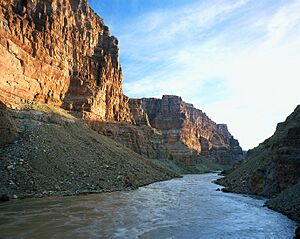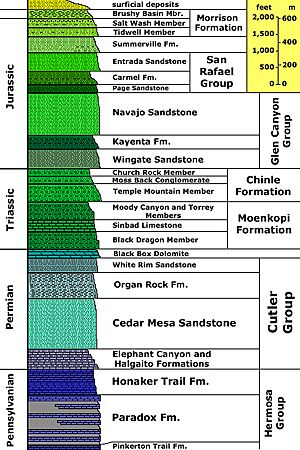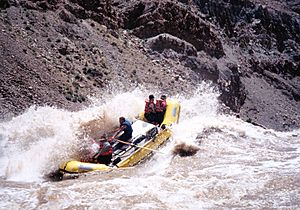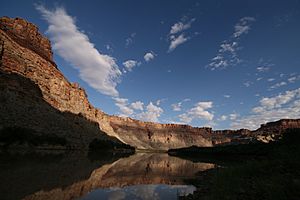Cataract Canyon facts for kids
Cataract Canyon is a 46-mile-long canyon in southern Utah. It's a special part of Canyonlands National Park and Glen Canyon National Recreation Area. The mighty Colorado River flows through it. The canyon starts where the Colorado River meets the Green River. It ends where the Dirty Devil River joins the Colorado. When Lake Powell is full, the lower half of the canyon is underwater.
Contents
How Cataract Canyon Was Formed
Cataract Canyon was carved by the Colorado River into the Colorado Plateau. This plateau is a huge raised area of land in the American Southwest. Millions of years ago, this whole area was near sea level. Over time, oceans moved in and out, leaving behind many layers of rock. These layers were laid down flat, one on top of the other.
About 70 to 80 million years ago, big movements in the Earth's crust lifted the entire region. This event is called the Laramide orogeny. After the land rose, the Colorado River began cutting through these rock layers. This exposed the different colored rock layers we see today. The oldest rock layer in Cataract Canyon is about 320 million years old!
A Look Back in Time
Long before European settlers arrived, Indigenous peoples lived in the Canyonlands area. It is thought that the Fremont culture was among them. They left behind amazing Rock art and ruins in Cataract Canyon. Some of these are over 800 years old.
Because the canyon was so far away, it took a long time for explorers to find it. The Colorado River and its canyons were seen more as a barrier than a place to explore. The first European known to reach Cataract Canyon was a fur trapper named Denis Julien in 1836. He carved his name into a rock wall, but this carving is now covered by Lake Powell.
The Powell Expedition
The first organized group to travel the entire length of Cataract Canyon was the Powell Geographic Expedition of 1869. It was led by John Wesley Powell. He was a Civil War veteran who had lost an arm. In 1869, Powell and his men started their journey in wooden boats. They began near Green River, Wyoming, and floated down the Green River. They reached the Colorado River at the top of Cataract Canyon.
The rapids in Cataract Canyon were very scary for Powell and his crew. They had to carry their boats around every single rapid. This was a very hard and tiring job. Because of these difficult rapids, Powell named the canyon "Cataract Canyon." A "cataract" is a large waterfall or a rush of water. After leaving Cataract Canyon, Powell continued his trip. He went through Glen Canyon (now under Lake Powell) and then the famous Grand Canyon. His journey ended near the Virgin River.
Later River Runners
After Powell, other river runners followed. Nathanial Galloway made many trips through the canyon starting in 1894. He helped create rowing techniques that river runners still use today. Brothers Emery and Ellsworth Kolb traveled through the canyon in 1911. They later showed videos of their river adventures at their studio at the Grand Canyon.
Buzz Holmstrom made a solo trip through Cataract Canyon and the Grand Canyon in 1937. He ended his journey at the newly built Hoover Dam. The first company to offer guided trips through Cataract Canyon was started by Norman Nevills in 1938.
In the early 1950s, rubber rafts became available. These were leftover from World War II. River runners found these rubber rafts much easier to steer and more forgiving than wooden boats. With this new equipment, many companies began offering trips through the Grand Canyon and Cataract Canyon.
Exciting Whitewater Rafting
Cataract Canyon is still a very popular place for whitewater rafting today. The rapids here are known as "big water." This means they are large and powerful, much like the rapids in the Grand Canyon. Cataract Canyon rapids are rated on the Class I-VI International Scale of River Difficulty. This is different from the Grand Canyon, which uses a scale of one to ten.
Unlike the Grand Canyon, the flow of the Colorado River through Cataract Canyon is mostly natural. It's far enough downstream from any dams. This means the river can get very high during spring. This happens when a lot of snow melts in the mountains that feed the Colorado River. During an average spring, the river can peak at about 52,000 cubic feet per second. The highest flow ever recorded was 114,900 cubic feet per second on May 27, 1984. The rapids become difficult when the flow is above 30,000 cubic feet per second. They become extreme when the flow is above 50,000 cubic feet per second.
Most rapids in Cataract Canyon are simply named Rapid 1, Rapid 2, and so on. But some rapids have special names because they are so famous or challenging. The "Big Drops" are especially well-known. These are three rapids very close together: Big Drop 1, Big Drop 2, and Big Drop 3. When the water is high, these three rapids can merge into one very large, powerful rapid. They contain huge water features like "Little Niagara," "Satan's Gut," and "The Claw."
Sometimes, when the water is very high, the National Park Service sets up a camp below the Big Drops. They use a jetboat to help rescue rafts and people who might flip over. However, all river runners should be ready to rescue themselves. They should not rely on the National Park Service for help.
In the past, Cataract Canyon had other challenging rapids. "Gypsum Canyon Rapid" and "Dark Canyon Rapid" were very hard to navigate. However, these rapids are now underwater. They are covered by Lake Powell and its sediments.
River trips through Cataract Canyon usually start on calmer water. Most groups begin at Potash (on the Colorado River) or Mineral Bottom (on the Green River). They spend up to five days floating before reaching the rapids of Cataract Canyon. Motorized trips can get to the canyon much faster, sometimes in just one day.
After running the rapids, all groups must cross Lake Powell. They then reach their take-out point at the Dirty Devil River or Hite Marina. Depending on the water level in Lake Powell, groups might have to travel up to 35 miles across the lake.
Many companies offer guided trips through Cataract Canyon. These trips can last from one to six days. They use both motorized and non-motorized boats. If you want to go on a private trip, you need to get a permit from the National Park Service first.
Images for kids









